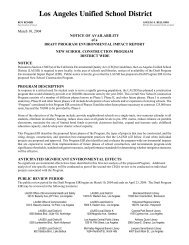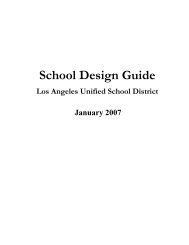Site-Specific Health and Safety Plan (HASP) - Laschools.org
Site-Specific Health and Safety Plan (HASP) - Laschools.org
Site-Specific Health and Safety Plan (HASP) - Laschools.org
Create successful ePaper yourself
Turn your PDF publications into a flip-book with our unique Google optimized e-Paper software.
LAUSD Proposed South Region High School #9 & Middle School #4<br />
6-6<br />
December 2006<br />
<strong>Site</strong> <strong>Specific</strong> <strong>Health</strong> & <strong>Safety</strong> <strong>Plan</strong> (<strong>HASP</strong>)<br />
• Crane Operations. Consider special requirements for operations, maintenance, <strong>and</strong><br />
heavy lifting operation. All lifts must be planned in accordance with the limitations of<br />
cranes being used. Critical lift plans are required when two cranes are used<br />
simultaneously. Crane operator certification is required when the boom length exceeds<br />
100 feet.<br />
• Fall Protection. Fall protection is required when employees are working more than six<br />
(6) feet above the normal work surface level. Consider how <strong>and</strong> where ladders, scaffold,<br />
work platforms, or lifts (including scissors or aerial lifts), roofing work <strong>and</strong> leading edges<br />
are used. Evaluate protective measures such as fall protection plans, use of personal fall<br />
arrest systems, <strong>and</strong> the work surfaces for slip <strong>and</strong> fall hazards <strong>and</strong> protection.<br />
• Field Activities. Many different types of activities occur in the field from excavations,<br />
groundwater sampling, soil sampling, liner installation, well installation <strong>and</strong> monitoring,<br />
<strong>and</strong> pump tests. A variety of hazards could be incurred with each activity such as<br />
biological, slip/trips/falls <strong>and</strong> lacerations. An activity hazard analysis is required for each<br />
different field activity to identify the hazards <strong>and</strong> controls.<br />
• Field Visit. When a field visit occurs, it may be before any field activities are taking<br />
place. However, there may still be hazards present such as walking or driving in fields<br />
with uneven terrain, poisonous vegetation, etc. Although personal protective equipment<br />
such as a hard hat <strong>and</strong> safety glasses may not be needed, sturdy work boots, long pants,<br />
long sleeve shirts <strong>and</strong> sunscreen may be necessary.<br />
• Heavy Equipment Operation. Evaluate the use of heavy equipment in operations such<br />
as site clearing, grading, drilling <strong>and</strong> excavation or lifting. Controls should include<br />
equipment alarms, use of qualified operators, equipment inspections, <strong>and</strong> any specific<br />
OSHA regulatory requirements.<br />
• Material H<strong>and</strong>ling. Consider the size <strong>and</strong> weight of loads, the equipment to be used,<br />
how the equipment is set up <strong>and</strong> protected, <strong>and</strong> safety <strong>and</strong> maintenance inspections of<br />
material h<strong>and</strong>ling <strong>and</strong> rigging equipment. Also consider employee training in the use of<br />
the equipment or personal body mechanics when engaged in manual material h<strong>and</strong>ling<br />
activities.<br />
• Material Storage. Consider where materials <strong>and</strong> equipment will be stored on site.<br />
Implement measures to protect against chemical spills/releases, fire, v<strong>and</strong>alism <strong>and</strong> theft<br />
of tools, equipment, or materials. Also consider the hazards that may exist for workers<br />
when they are storing or retrieving those materials.<br />
• Mobilization/Demobilization. Conduct an initial site inspection for pre-job planning.<br />
The inspection should cover potential exposures such as the location of electrical lines,<br />
underground utilities, nearby structures, traffic conditions, site security needs, public<br />
exposures general liability, <strong>and</strong> other potential exposures.<br />
• Portable H<strong>and</strong> <strong>and</strong> Power Tools. Evaluate the tools to be used <strong>and</strong> the ways that<br />
workers are protected from the hazards associated with the use of tools. Consider tool<br />
maintenance requirements; electrical requirements; the use of ground fault circuit<br />
197







